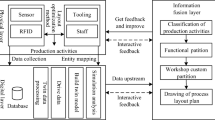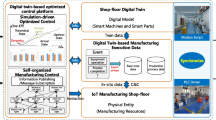Abstract
Smart manufacturing systems combine sensor systems and manufacturing processes, and they have been widely adopted in the industry to solve real production problems, help manufacturing enterprises achieve rapid decision-making, and improve manufacturing value. However, manufacturing enterprises still face huge challenges with the coexistence of continuously changing dynamic demands, collaborative scheduling of dynamic resources, precise matching of manufacturing resources, and multiple resource constraints. To address this challenge, this research combines digital twin (DT) technology to propose a smart site-selection system with dynamic resource-accurate matching characteristics based on the attributes and associations of both resource sides, supply and demand sides, and site-selection sides, which can integrate and optimize resources according to the requirements of manufacturing tasks. In addition, by establishing the discovery mechanism of bottleneck processes and resource allocation methods, generating configuration priorities, and thus reducing the solution space for resource allocation, the precise allocation of limited resources is achieved more quickly and easily, and the scheduling chaos in the parallel scheduling of multiple resources is solved and the multi-objective robust optimization model is solved by combining smart optimization algorithms. Combined with the example analysis, the results show that the smart site-selection system and multi-resource cyclic allocation mechanism proposed in this paper can collaboratively match a large amount of dynamic resources, and the utilization rate of idle manufacturing resources can be increased by 60%. This research effectively realizes the optimal allocation of multiple manufacturing resources in a resource-constrained environment and helps manufacturing enterprises create more manufacturing value.











Similar content being viewed by others
References
Tao F, Qi Q (2019) New IT driven service-oriented smart manufacturing: framework and characteristics. IEEE Trans Syst Man, Cybern Syst 49:81–91
Kang H, Lee J, Choi S, Kim H, Park J, Son J, Kim B, Noh S (2016) Smart manufacturing: past research, present findings, and future directions. Int J Precis Eng Manuf - Green Technol 3:111–128
Fawzi H, Tabuada P, Diggavi S (2014) Secure estimation and control for cyber-physical systems under adversarial attacks. IEEE Trans Automat Contr 59:1454–1467
Qi Q, Tao F (2018) Digital twin and big data towards smart manufacturing and Industry 4.0: 360 degree comparison. IEEE Access 6:3585–3593
Qi Q, Tao F, Hu T, Anwer N, Liu A, Wei Y, Wang L, Nee A (2021) Enabling technologies and tools for digital twin. J Manuf Syst 58:3–21
Wang G, Zhang G, Guo X, Zhang Y (2021) Digital twin-driven service model and optimal allocation of manufacturing resources in shared manufacturing. J Manuf Syst 59:165–179
Wu J, Zhang W, Zhang S, Liu Y, Meng X (2013) A matrix-based Bayesian approach for manufacturing resource allocation planning in supply chain management. Int J Prod Res 51:1451–1463
Lee C, Choy K, Law K, Ho G (2014) Application of smart data management in resource allocation for effective operation of manufacturing systems. J Manuf Syst 33:412–422
Chu W, Li Y, Liu C, Mou W, Tang L (2014) A manufacturing resource allocation method with knowledge-based fuzzy comprehensive evaluation for aircraft structural parts. Int J Prod Res 52:3239–3258
Luo D, Guan Z, He C, Gong Y, Yue L (2021) Data-driven cloud simulation architecture for automated flexible production lines: application in real smart factories. Int J Prod Res 60:3751–3773
Lee C, Choy K, Ho G, Law K (2013) A RFID-based Resource Allocation System for garment manufacturing. Expert Syst Appl 40:784–799
Cao Y, Wu Z, Liu T, Gao Z, Yang J (2016) Multivariate process capability evaluation of cloud manufacturing resource based on intuitionistic fuzzy set. Int J Adv Manuf Technol 84:227–237
Wang K, Lin Y (2007) Resource allocation by genetic algorithm with fuzzy inference. Expert Syst Appl 33:1025–1035
Guo S, Du B, Peng Z, Huang X, Li Y (2015) Manufacturing resource combinatorial optimization for large complex equipment in group manufacturing: a cluster-based genetic algorithm. Mechatronics 31:101–115
Chen Z, Chen Z, Zhou D, Shao C, Pan E (2022) Optimal replacement policy for multi-state manufacturing system with economic and resource dependence under epistemic uncertainty. Int J Prod Res 61:6772–6790. https://doi.org/10.1080/00207543.2022.2137595
Xu W, Yu Y (2018) Optimal allocation method of discrete manufacturing resources for demand coordination between suppliers and customers in a fuzzy environment. Complexity. https://doi.org/10.1155/2018/1410957
Cheng Y, Zhang Y, Ji P, Xu W, Zhou Z, Tao F (2018) Cyber-physical integration for moving digital factories forward towards smart manufacturing: a survey. Int J Adv Manuf Technol 97:1209–1221
Lopes T, Michels A, Sikora C, Brauner N, Magatao L (2021) Assembly line balancing for two cycle times: anticipating demand fluctuations. Comput Ind Eng 162. https://doi.org/10.1016/j.cie.2021.107685
Liu Y, Zhang Q, Ouyang Z, Huang H (2021) Integrated production planning and preventive maintenance scheduling for synchronized parallel machines. Reliab Eng Syst Saf 215. https://doi.org/10.1016/j.ress.2021.107869
Vairaktarakis G (2000) Robust multi-item newsboy models with a budget constraint. Int J Prod Econ 66:213–226
Lattanzi L, Raffaeli R, Peruzzini M, Pellicciari M (2021) Digital twin for smart manufacturing: a review of concepts towards a practical industrial implementation. Int J Comput Integr Manuf 34:567–597
Liu M, Tang J, Ge M, Jiang Z, Hu J, Ling L (2009) Dynamic prediction method of production logistics bottleneck based on bottleneck index. CHINESE J Mech Eng 22:710–716
Dawande M, Feng Z, Janakiraman G (2021) On the structure of bottlenecks in processes. Manage Sci 67:3853–3870
Ma S, Chen R (1996) Production planning and control system model based on multi-level I/OC. J Huazhong Univ of Sci & Tech 24:96–98 (in Chinese)
Qu G, Zhang H, Liu Z, Zhang Z, Zhang Q (2016) Group decision making based on λ-Shapley Choquet integral novel intuitionistic fuzzy TOPSIS method. Syst Eng — Theor Pract 36:726–742 (in Chinese)
Meng F, Zhang Q, Cheng H (2013) Approaches to multiple-criteria group decision making based on interval-valued intuitionistic fuzzy Choquet integral with respect to the generalized λ-Shapley index. Knowledge-Based Syst 37:237–249
Liu C, Kang S (2014) A video-enabled dynamic site planner. Comput Civ Build Eng – Proc 2014 Int Conf Comput Civ Build Eng 353:1562–1569
Xu Z (2010) Choquet integrals of weighted intuitionistic fuzzy information. Inf Sci (Ny) 180:726–736
Marichal JL (2001) An axiomatic approach of the discrete Sugeno integral as a tool to aggregate interacting criteria in a qualitative framework. IEEE Trans Fuzzy Syst 9:164–172
Lin L, Yuan X, Xia Z (2007) Multicriteria fuzzy decision-making methods based on intuitionistic fuzzy sets. J Comput Syst Sci 73:84–88
31. Ding Y, Xia T, Huang M, Zheng Y, Miao R, Xi L (2022) Predictive maintenance and upgrade scheduling for production line under multi-period product-service paradigm. Eng Optim:1723–1741. https://doi.org/10.1080/0305215X.2022.2122457
Yang B, Wang S, Li S, Jin T (2022) A robust service composition and optimal selection method for cloud manufacturing. Int J Prod Res 60:1134–1152
Hasan M, Al-Rizzo H (2020) Task scheduling in Internet of Things cloud environment using a robust particle swarm optimization. Concurr Comput Exp 32. https://doi.org/10.1002/cpe.5442
Gheisariha E, Tavana M, Jolai F, Rabiee M (2021) A simulation-optimization model for solving flexible flow shop scheduling problems with rework and transportation. Math Comput Simul 180:152–178
Lim W, Jambek A, Neoh S (2015) Kursawe and ZDT functions optimization using hybrid micro genetic algorithm (HMGA). SOFT Comput 19:3571–3580
Zheng K, Yang R, Xu H, Hu J (2017) A new distribution metric for comparing Pareto optimal solutions. Struct Multidiscip Optim 55:53–62
Rabiee M, Zandieh M, Ramezani P (2012) Bi-objective partial flexible job shop scheduling problem: NSGA-II, NRGA, MOGA and PAES approaches. Int J Prod Res 50:7327–7342
Zhang C, Xu W, Liu J, Liu Z, Zhou Z, Pham D (2021) Digital twin-enabled reconfigurable modeling for smart manufacturing systems. Int J Comput Integr Manuf 34:709–733
Liao S, Wu J, Bashir A, Yang W, Li JH, Tariq U (2022) Digital twin consensus for blockchain-enabled intelligent transportation systems in smart cities. IEEE Trans Intell Transp Syst 23:22619–22629
Croatti A, Gabellini M, Montagna S, Ricci A (2020) On the integration of agents and digital twins in healthcare. J Med Syst 44. https://doi.org/10.1007/s10916-020-01623-5
Wu D, Liu S, Zhang L, Terpenny J, Gao R, Kurfess T, Guzzo J (2017) A fog computing-based framework for process monitoring and prognosis in cyber-manufacturing. J Manuf Syst 43:25–34
Funding
This work was supported by the National Natural Science Foundation of China (grant number 71801160); Liaoning Provincial Education Department Scientific Research Project Funding (grant number WJGD2019002); Liaoning Provincial Social Science Foundation (grant number L16BGL035); Special Project for Humanities and Social Science Bases of Education Department (grant number ZJ2015037); Liaoning Provincial Education Science General Subject (grant number JG20DB342); Project of Liaoning Provincial Department of Education (grant number LJKR0076); and Shenyang Social Science Project (grant number SYSK2022-JD-02). The authors would like to acknowledge the funding support from Shenyang University of Technology, which is associated with this work.
Author information
Authors and Affiliations
Contributions
All authors contributed to the study conception and design. Material preparation, data collection, and analysis were performed by Baotong Wu. The first draft of the manuscript was written by Baotong Wu and all authors commented on previous versions of the manuscript. All authors read and approved the final manuscript.
Corresponding author
Ethics declarations
Competing interests
The authors declare no competing interests.
Additional information
Publisher's Note
Springer Nature remains neutral with regard to jurisdictional claims in published maps and institutional affiliations.
Rights and permissions
Springer Nature or its licensor (e.g. a society or other partner) holds exclusive rights to this article under a publishing agreement with the author(s) or other rightsholder(s); author self-archiving of the accepted manuscript version of this article is solely governed by the terms of such publishing agreement and applicable law.
About this article
Cite this article
Tang, Q., Wu, B. A digital twin-driven multi-resource constrained location system for resource allocation. Int J Adv Manuf Technol 130, 4359–4385 (2024). https://doi.org/10.1007/s00170-023-12886-w
Received:
Accepted:
Published:
Issue Date:
DOI: https://doi.org/10.1007/s00170-023-12886-w




